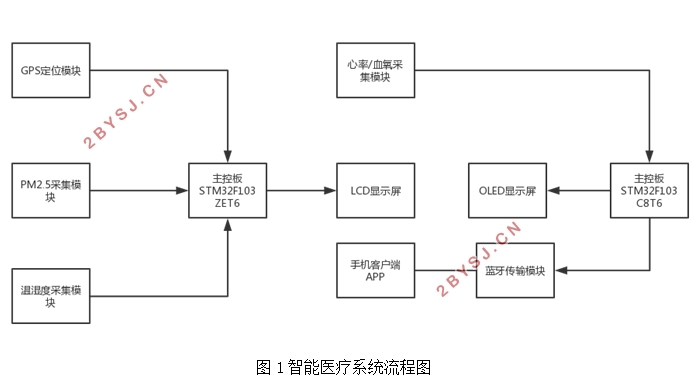基于STM32的智能医疗系统的研究与开发
无需注册登录,支付后按照提示操作即可获取该资料.
基于STM32的智能医疗系统的研究与开发(论文14700字)
摘要:21世纪初,科技迈着坚实的步伐,在中国乃至全世界飞快地发展。本文主要提供了一种基于STM32单片机的智能医疗系统的设计方案。此智能医疗系统以STM32F103系列单片机为核心主控板,结合温湿度采集模块、GPS定位模块、PM2.5采集模块、心率/血氧采集模块收集病人的身体指标数据,并将收集到的数据显示在LCD屏幕上,最后将数据通过蓝牙模块传入用户手机APP中。用户可以通过查看手机实时监测病人的身体情况。本论文首先会对此系统的设计思想、原理进行说明,其次,根据设计思想和原理中所用到的模块和单片机,从软、硬件两方面说明各个部分的原理及用到的算法说明,并分析、解释整体系统是如何实现的,最后,对于在实验过程中出现的问题,分析问题并说明在实验中是如何解决问题的。
关键词:算法;stm32;人工智能
Design And Implement OF Smart Medical System Based ON STM32
Abstract:At the beginning of the 21st century, science and technology took firm steps and developed rapidly in China and evenin the whole world. This article mainly provides a design scheme of smart medical system based on STM32 microcontroller. This intelligent medical system uses the STM32F103 series single-chip microcomputer as the central control board, and combines the temperature and humidity acquisition module, the GPS positioning module, the PM2.5 acquisition module, and the heart rate&SPO2 acquisition module to collect the patient's physical index data and display the collected data. On the LCD screen, the data is finally transmitted to the user's mobile phone APP through the Bluetooth module. The user can monitor the physical condition of the patient currently by viewing their mobile phone. This paper will initially explain thedesign ideas and principles of this system. Secondly, according to the modules andmicrocontroller used in the design ideas and principles, the principle of each part and the description of the algorithms used are explained from both hardware and software aspects. Explain how the overall system is implemented. Finally, for the problems that arise during the experiment, I’ll explain the reasons for the problems and provide solutions.
Key words:algorithm;stm32;artificial intelligence

目录
1绪论 5
1.1研究背景 5
1.2关于智能医疗的必要概念 5
1.2.1大数据和智能医疗的关系 5
1.2.2智能医疗应用举例 6
1.3国内外智能医疗发展情况 6
1.3.1智能医疗的发展阶段 6
1.3.2国外智能医疗发展现状 6
1.3.3国内智能医疗发展现状 6
1.4本章小结 6
2智能医疗系统的总体设计 7
2.1医疗系统总体设计 7
2.1.1医疗系统总体要求 7
2.1.2整体系统设计方案 7
2.1.3硬件部分 7
2.1.4软件部分 7
2.1.5系统总体设计框架 7
2.2智能医疗系统分析 8
2.2.1智能医疗系统的设计难点 8
2.3本章小结 8
3 系统硬件的选择与设计 8
3.1主控单片机的选用 8
3.1.1ARM处理器的介绍 8
3.1.2单片机STM32F103的介绍 9
3.2主控单片机STM32F103ZET6的内部结构 10
3.2.1STM32F103ZET6的最小系统板 10
3.2.2STM32F103的下载方式 12
3.3GPS定位模块 13
3.3.1GPS定位模块的介绍 13
3.3.2GPS定位模块的工作原理 13
3.3.3 时钟脉冲电路 14
3.4温湿度采集模块 14
3.4.1温湿度采集模块的介绍 14
3.4.2DHT11温度采集模块的工作原理 15
3.5 PM2.5采集模块 16
3.5.1 PM2.5采集模块的介绍 16
3.5.2 PM2.5模块的工作原理 16
3.6心率/血氧采集模块 17
3.6.1心率血氧采集模块的介绍 17
3.6.2心率/血氧模块的工作原理 18
3.6.3 MAX30100的内置ADC 19
3.7蓝牙模块 19
3.7.1蓝牙模块的工作原理 19
3.8显示模块 19
3.8.1 TFT-LCD介绍 19
4系统软件的设计 21
4.1周边环境部分的软件设计 21
4.2 GPS模块的软件设计 21
4.2.1 GPS定位模块的数据传输 21
4.2.2串口通信 21
4.2.3NMEA-0183协议 22
4.3 PM2.5采集模块的软件设计 24
4.3.1定时器中断 24
4.4DHT11温度采集模块 25
4.4.1单总线协议 25
4.5病人身体指标检测部分的软件设计 26
4.6心率/血氧采集模块的软件设计 26
4.6.1心率/血氧采集模块的初始化 26
4.6.2 I2C协议 28
4.6.3读取数据的过程 29
4.6.4 DC消除 29
4.6.5滑动平均滤波算法 30
4.6.6血氧饱和度算法 31
4.7LCD显示部分的软件设计 32
4.8 智能医疗APP 33
4.9本章小结 36
5 设计结果与分析 36
5.1智能医疗系统的成品展示 36
5.1.1智能医疗系统的设计结果 36
5.1.2周边环境检测模块的测试结果 36
5.1.3病人身体指标检测部分的测试结果 37
5.2测试结果分析 39
5.2.1周边环境检测部分的数据分析 39
5.2.2病人身体指标检测部分 39
5.2.3实验中遇到的问题及解决方案 39
5.3本章小结 40
6 实验的总结与展望 40
6.1实验总结 40
6.2对未来的展望 40
参考文献: 40
致谢: 42
